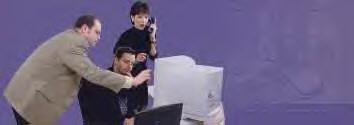Unwanted items
in the most generic sense may appear in the form of data files (items
of data), or programs (executables), either fully
installed on your computer in the normal fashion (using the Windows
Installer program), or simply stored in some folder location.
Removing an unwanted item from your computer can range
from a simple or minimal exercise, to the downright nerve-wracking.
Here are some of the most basic types of unwanted items.
First, let's identify the various types of 'unwanted
items' in
existence. Also for the purposes of this article, assume that a
Windows-based computer is the object of this discussion. |
|
Executable files
stored in some folder location simply need to be clicked on to
run as intended, or they can run if unintentionally triggered by
some other process. Some of these programs could be 'hostile', that
is they could be malware - a virus, trojan, spyware or Adware.
Here's a list of some of the more common types of unwanted
items that could be found on your system and some suggestions to
remove these unwanted computer items:
|
Unwanted Data Items: |
| |
To remove data
files - simply identify,
locate and delete the data file, followed by
emptying the trash can.
However, be aware that if security is an issue, simple
file deletion as described above will not completely
remove all traces of the data. To be sure that sensitive
data is removed 'forever', the data must be overwritten
with new data designed in accordance with recognized
secure methods. This is a rather complicated procedure
requiring help from an experienced technician.
It's theoretically possible to retrieve even data that
has been overwritten, so the solution often heard is
that the only secure way to prevent sensitive data from
ever being retrieved is to physically destroy the hard
disk originally used to store the data. Retrieving data
that has been overwritten would be way beyond the
capabilities of all but the most technically
sophisticated.
|
|
Cache Files: |
| |
Cache
files are used by Windows to help speed up the execution
of routing and/or repetitive operations. While these are
not 'unwanted' in the strictest sense of the term, over
time the cache file size may grow unnecessarily large,
thereby degrading computer performance
|
|
Internet Temporary
Files: |
| |
During the
course of the normal use of Internet Explorer of other
Internet browser, many temporary files are created.
|
|
Windows Temporary
Files: |
| |
Windows
creates temp files during software installation as well
as various other operations. These files provide the
ability to easily recover from various possible
'glitches' that may occur during execution of a given
process.
Similar to Cache files, Windows uses 'temp' (temporary)
files to provide smoother operation of various installed
programs. Temp files are conspicuous by their '.tmp'
file extension. For example, you will find temp files
being created whenever programs such as MSWord or Excel
are used.
Temporary Files can be removed by using the Disk Cleanup
tools in the Systems Tools folder included under
Accessories in your Windows Program list.
Click on the Start button, then select Programs, click
on it and open Accessories. Select System Tools and
proceed to Disk Cleanup. Follow the simple instructions.
You'll see helpful information here to guide you in
performing your Disk Cleanup.
|
|
Unwanted Installed
Programs: |
| |
Remove
executable files:
Any
program originally installed using the Windows installer
may be uninstalled by the usual (recommended) method of
going to the Control Panel and running the 'Add/Remove
Programs' utility. Many programs are also supplied with
their own uninstaller. In such cases this feature should
be used as a first option for its removal from your
computer.
It should be noted that if the program's own uninstaller
and/or Windows Add/Remove Program utility fail to remove
the program, other more intrusive means of removal may
be employed. Again, help from a professional computer
technician is probably the safest approach here.
|
|
Malware: |
| |
The
removal of malware (spyware, adware, etc.) is typically
the most challenging of all the procedures described
thus far. In fact, the initial obstacle is recognizing
that such an 'infestation' does indeed exist.
Some of the first signs of possible malware infestation
are:
 Erratic computer operation.
Erratic computer operation.
 Computer crashes.
Computer crashes.
 Slower-than-normal operation.
Slower-than-normal operation.
 Pop-up messages warning of virus infestation or other
problem (trying to scare you into taking some particular
action, such as visiting a website promising to fix the
problem).
Pop-up messages warning of virus infestation or other
problem (trying to scare you into taking some particular
action, such as visiting a website promising to fix the
problem).
 Your Home Page suddenly being changed from the normal
site
Your Home Page suddenly being changed from the normal
site
(home-page hijacking).
|
|
To be sure, there are
other factors that may slow down your computer or cause
erratic behavior, such as file corruption, or software
bugs. However, there are a few procedures you can follow
which will reduce or eliminate the possibility that your
computer is in fact the victim of a malware 'attack'. |
It makes good sense to run a complete
check for malware and remove any items found, and then perform the
routine maintenance procedures described here (Internet and Windows
temp file removal, etc.).
... Richard Rossbauer
|




